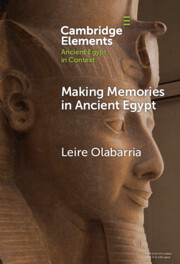1673 results
Epilogue
-
- Book:
- Henry James and the Writing of Transport
- Published online:
- 20 March 2025
- Print publication:
- 03 April 2025, pp 204-210
-
- Chapter
- Export citation
6 - (Inter)subjectivity, and More
-
- Book:
- Modality in Mind
- Published online:
- 25 March 2025
- Print publication:
- 27 March 2025, pp 195-232
-
- Chapter
- Export citation
5 - Beyond the Qualificational Hierarchy
-
- Book:
- Modality in Mind
- Published online:
- 25 March 2025
- Print publication:
- 27 March 2025, pp 152-194
-
- Chapter
- Export citation

Making Memories in Ancient Egypt
-
- Published online:
- 24 March 2025
- Print publication:
- 17 April 2025
-
- Element
-
- You have access
- HTML
- Export citation
11 - The Great Western Schism in History and Memory
- from Part II - Crises, Schisms, and Dissent
-
-
- Book:
- The Cambridge History of the Papacy
- Published online:
- 28 February 2025
- Print publication:
- 20 March 2025, pp 299-318
-
- Chapter
- Export citation
Chapter 5 - Neuropsychology
-
-
- Book:
- Essential Neuroscience for Psychiatrists
- Published online:
- 12 March 2025
- Print publication:
- 20 March 2025, pp 174-197
-
- Chapter
- Export citation
The Recognition of Nuclear Trauma in Sagashite imasu (I am Searching)
-
- Journal:
- Asia-Pacific Journal / Volume 13 / Issue 7 / February 2015
- Published online by Cambridge University Press:
- 14 March 2025, e8
-
- Article
- Export citation
Introduction: Re-examining Asia-Pacific War Memories: Grief, Narratives, and Memorials
-
- Journal:
- Asia-Pacific Journal / Volume 20 / Issue 10 / May 2022
- Published online by Cambridge University Press:
- 14 March 2025, e2
-
- Article
- Export citation
Strategic Remembering in Vietnam-US Relations: How a Monument of War Turns Into a Marker of Peace
-
- Journal:
- Asia-Pacific Journal / Volume 22 / Issue 4 / April 2024
- Published online by Cambridge University Press:
- 14 March 2025, e2
-
- Article
-
- You have access
- Export citation
The Legacy of the Second Sino-Japanese War in the People's Republic of China: Mapping the Official Discourses of Memory
-
- Journal:
- Asia-Pacific Journal / Volume 20 / Issue 11 / June 2022
- Published online by Cambridge University Press:
- 14 March 2025, e4
-
- Article
- Export citation
Tsushima Yūko and the Ethics of Cohabitation
-
- Journal:
- Asia-Pacific Journal / Volume 16 / Issue 12 / June 2018
- Published online by Cambridge University Press:
- 14 March 2025, e5
-
- Article
- Export citation
Yasukuni Shrine, the Yushukan Military Museum, and Japan’s Place in the World
-
- Journal:
- Asia-Pacific Journal / Volume 22 / Issue 7 / July 2024
- Published online by Cambridge University Press:
- 14 March 2025, e3
-
- Article
-
- You have access
- Export citation
Asian American Memory Activism: A Roundtable Discussion
-
- Journal:
- Asia-Pacific Journal / Volume 22 / Issue 9 / September 2024
- Published online by Cambridge University Press:
- 14 March 2025, e5
-
- Article
-
- You have access
- Export citation
“Comfort Women” – New Research from Japan, Singapore, Malaysia, and Indonesia
-
- Journal:
- Asia-Pacific Journal / Volume 22 / Issue 5 / May 2024
- Published online by Cambridge University Press:
- 14 March 2025, e3
-
- Article
-
- You have access
- Export citation
Art as Anti-Nuclear Activism: Takeda Shinpei's Hibakusha Voiceprints in Alpha Decay
-
- Journal:
- Asia-Pacific Journal / Volume 21 / Issue 11 / November 2023
- Published online by Cambridge University Press:
- 14 March 2025, e1
-
- Article
- Export citation
Rethinking “Peace” of Hiroshima: Restoring the Subject, and the Logic of “the Only A-bombed Nation”
-
- Journal:
- Asia-Pacific Journal / Volume 21 / Issue 12 / December 2023
- Published online by Cambridge University Press:
- 14 March 2025, e3
-
- Article
- Export citation
Justice in the Time of Cholera
-
- Journal:
- Asia-Pacific Journal / Volume 22 / Issue 3 / March 2024
- Published online by Cambridge University Press:
- 14 March 2025, e3
-
- Article
-
- You have access
- Export citation
The History Problem: The Politics of War Commemoration in East Asia
-
- Journal:
- Asia-Pacific Journal / Volume 15 / Issue 15 / August 2017
- Published online by Cambridge University Press:
- 14 March 2025, e3
-
- Article
- Export citation
Remembering/imagining: Shona Illingworth’s time present and Trinh-T Minh-Ha’s forgetting Vietnam
- Part of
-
- Journal:
- Memory, Mind & Media / Volume 4 / 2025
- Published online by Cambridge University Press:
- 28 February 2025, e1
-
- Article
-
- You have access
- Open access
- HTML
- Export citation
Historical Scholarship and the Public Square: The Belgian Commission on Colonialism Through the Lens of Wiriyamu
-
- Journal:
- The Journal of African History , First View
- Published online by Cambridge University Press:
- 12 February 2025, pp. 1-8
-
- Article
-
- You have access
- Open access
- HTML
- Export citation


